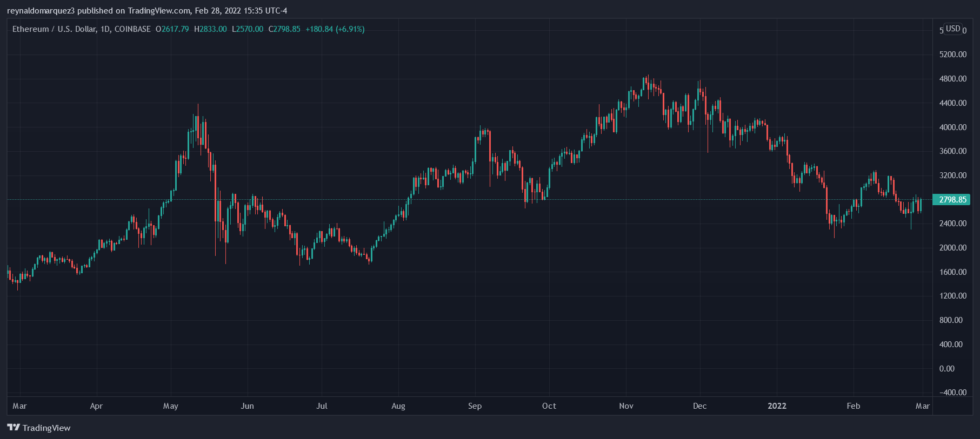The Massachusetts Institute of Technology (MIT) published their 2022 technological breakthrough and included the Proof-of-Stake (PoS) consensus algorithm to be adopted by Ethereum. Posted via the MIT Technology Review, the algorithm occupies spot 6 in a top 10 rank.
Related Reading | Ethereum Heads Towards 100K Transactions Per Second? Buterin Talks About Post-Merger Future
Comprised of varied technological use cases, such as COVID-19 variant tracking, long-lasting batteries, Malaria vaccines, Artificial Intelligence for drug development, compact fusion reactors, and more. The consensus algorithm that will support Ethereum’s next era broke the rank as an alternative to Bitcoin’s Proof-of-Work.
Per the MIT Technology Review, Bitcoin “uses a huge amount of electricity” claiming it consumes more energy than Finland in 2021. In opposition, Proof-of-Stake cuts energy consumption, the academic institution said, by around 99.95%.
The second crypto by market cap already launched its Beacon Chain, the PoS supported blockchain in the process of growing its number of validators. In the first half of 2022, Ethereum will undergo a process known as “The Merge”.
This will combine the current blockchain or ETH 1.0, recently named execution layer, with its consensus layer or ETH 2.0, finally leaving PoW behind. The MIT stated the following on their view over this consensus model, outlining the future of Ethereum, and the present of Cardano, Algorand, and other PoS blockchains:
With proof of stake, validators don’t have to vie against one another, spending big on energy and computing hardware. Instead, their cache, or stake, of cryptocurrency allows them to enter a lottery. Those who are chosen gain the authority to verify a set of transactions (and so earn more cryptocurrency).
An Obsolete Debate? Ethereum PoS v. Bitcoin PoW
The MIT claims The Merge could mark a turning point for Ethereum, but also for its consensus mechanism. If successful, other networks could adopt a similar model, the academic institution said.
However, in the top 10 cryptos by market cap, XRP, Binance Coin (BNB), Terra (LUNA), Solana (SOL), Cardano (ADA), Avalanche (AVAX), all run on PoS or a similar consensus model. Bitcoin is the only large-cap cryptocurrency with a PoW consensus algorithm.
The MIT Technology Review seems to be replicating an argument that fails to consider the complexities of Bitcoin mining and its tendency towards renewable sources of energy. As Bitcoinist reported back in January, the Bitcoin mining industry could be a “misunderstood” industry.
An article posted by Castle Island Ventures’ Nic Carter highlights the benefits and advantages of a PoW model. His argument is based on Bitcoin’s network capacity to take excess energy and turn it into a hard asset, its geographical agnosticism, and its capacity to take otherwise unviable models and turn them into reality. Carter said:
Bitcoin miners are attracted to the cheap power—they are willing to scoop up the stranded power and rescue the economics of wind and solar installations that might otherwise be uneconomical.
On the other hand, some consider PoS consensus models to favor the majorities or the underlying asset whales. Thus, leading to more centralized governance and less network decentralization.
If The Merge is successfully implemented, Bitcoin and Ethereum will co-exist with two opposite approaches to consensus. Time might be the final judge that settles that debate which, for others, seems outdated as they focused on benefiting from both networks.
Related Reading | What U.S. Lawmakers Need To Know About Proof-Of-Work Mining’s Energy Consumption
As of press time, ETH trades at $2,798 with a 3.7% profit in the past 24-hours.

- 100k
- 2021
- 2022
- About
- ADA
- advantages
- Algorand
- algorithm
- All
- already
- amount
- Another
- around
- article
- artificial
- artificial intelligence
- asset
- authority
- Avalanche
- beacon chain
- benefits
- binance
- Binance Coin
- Binance Coin (BNB)
- Bitcoin
- Bitcoin mining
- Bitcoinist
- blockchain
- bnb
- Buterin
- Capacity
- Cardano
- Cardano (ADA)
- cases
- claims
- Coin
- complexities
- computing
- Consensus
- consumption
- could
- COVID-19
- crypto
- cryptocurrency
- Current
- debate
- Decentralization
- Development
- drug
- Economics
- energy
- ETH
- Eth 2.0
- ethereum
- ETHUSD
- Finally
- First
- focused
- following
- future
- geographical
- governance
- Growing
- Hardware
- HTTPS
- huge
- implemented
- included
- industry
- Institution
- Intelligence
- IT
- January
- known
- lawmakers
- leading
- lottery
- mark
- Market
- Market Cap
- massachusetts
- Massachusetts Institute of technology
- Miners
- Mining
- MIT
- model
- models
- network
- networks
- opposition
- Other
- otherwise
- PoS
- PoW
- power
- present
- press
- process
- Profit
- profits
- proof
- Proof-of-Stake
- proof-of-stake (PoS)
- Proof-of-Work
- Reading
- Reality
- review
- Run
- Said
- set
- settles
- similar
- So
- Solana
- solar
- Spending
- Spot
- stake
- successful
- Successfully
- support
- Supported
- Talks
- Technology
- Terra
- time
- top
- Tracking
- trades
- Transactions
- u.s.
- use
- View
- whales
- WHO
- wind
- xrp













